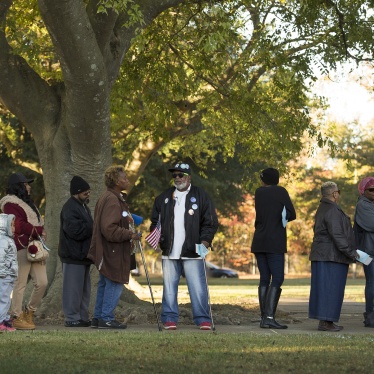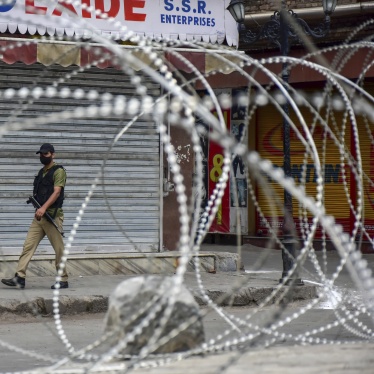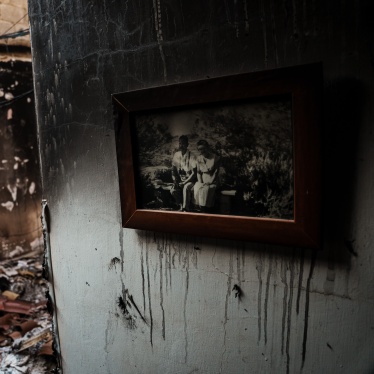On October 3, 2016, Human Rights Watch sent this letter to US Attorney General Lynch with recommendations on the Department of Justice's proposed changes to its data collection under its Arrest-Related Deaths program, as well as additional recommendations to improve data collection under the Death in Custody Reporting Act of 2013.
The Honorable Loretta Lynch
Attorney General
US Department of Justice
950 Pennsylvania Avenue, NW
Washington, DC 20530
Re: Human Rights Watch Comments on Reforms to Data Collection under the Arrest-Related Deaths Program
Dear Attorney General Lynch:
Human Rights Watch is writing to offer the following recommendations on the Department of Justice’s (DOJ) proposed changes to its data collection under its Arrest-Related Deaths (ARD) Program, as well as additional recommendations to improve data collection under the Death in Custody Reporting Act (DICRA) of 2013.
First, we are encouraged by DOJ’s Bureau of Justice Statistics’ (BJS) decision to improve the quality and quantity of data it collects about arrest-related deaths. We note that we have been informed by BJS that it will soon post the proposed ARD data collection methodology in its entirety and provide an additional review and comment period.
Until that time, we offer two general recommendations on the proposed ARD data collection program:
- The proposal notes that BJS will collect decedent demographic data from local law enforcement agencies. We recommend that demographic data on law enforcement personnel who used force, weapons, or restraint tactics on the decedent during the incident also be collected. This demographic data should include age, gender, and race.
- We also recommend that BJS release public-use datasets of the disaggregated raw data, including all variables, compiled from all of the local law enforcement agency and medical examiner/coroner forms annually for individual reports and quarterly for the summaries.
Beyond data collection under the ARD program, we also urge BJS to improve its data collection on deaths of people held in prisons, jails, and related custodial facilities.
In our May 2015 report, Callous and Cruel, Human Rights Watch documented deaths behind bars of persons with mental health problems who were stunned with electric shock devices, restrained, subjected to massive amounts of pepper spray, and/or struck by correctional staff. Deaths of inmates (with or without mental health problems) at the hands of jail or prison staff continue to surface with unfortunate regularity in the news media. Yet our research including conversations with correctional experts suggests that there may be jail and prison inmates whose deaths following staff use of force are not reported publicly. Unknown deaths in custody that constitute homicides by correctional officers should not be permitted.
Human Rights Watch believes the several forms currently used by BJS to collect information about inmate deaths could be improved. For example, while the forms used to report inmate deaths (for example, form CJ-9 for jail inmates or NPS 4-A for prison inmates) require the person completing the form to refer to a medical examiner or coroner’s evaluation of the cause of death, there is no attendant requirement that the person completing the form (who may be a correctional administrator or correctional agency health personnel) quote completely or accurately or attach the results of: any incident report related to the death; a medical examiner or coroner’s evaluation of cause of death; or the death certificate.
An autopsy or certificate of death may indicate that the decedent died of cerebral hemorrhage caused by blunt force trauma but the staff person filling out the form may not include the “blunt force trauma,” much less describe how the trauma happened or the role of staff in the death.
Similarly, a decedent may have died from cardiac arrest during jail staff efforts to restrain him instituted because of an inmate’s behavior. The correctional staff may list the cardiac arrest, but not the staff restraints imposed just prior to the death. In addition, the category on the forms (for example, form CJ-9 and NPS 4-A) of “homicide” does not differentiate between deaths at hands of correctional staff and inmates. This means that the public has no way of knowing how many of the deaths were a consequence of staff use of force. Finally, the current form uses the term “homicide” for deaths that are incidental to staff use of force. While the term as used by medical personnel does not indicate legal culpability, it may be that correctional administrators are reluctant to label fatal injuries at the hands of staff as “homicides.”
We recommend the following:
- BJS should consult with corrections, use of force, and forensic experts to determine how to gather all the pertinent information on all the cases connected to staff use of force as efficiently as possible and with the least burden to correctional agencies and medical examiner/coroner offices.
- Agencies should obtain and submit to the BJS (or the BJS should obtain directly) copies of incident reports, autopsy results, and certificates of death for any death that is not result of illness, suicide, or injury at the hands of another inmate.
- Forms should distinguish and require separate reporting of deaths that are incidental to staff use of force from those that are incidental to inmate violence.
- Forms that fail to describe a homicide with sufficient specificity to establish whether it was incidental to staff use of force should be returned to the correctional agency with the request that a complete description be provided along with supporting documentation, including the certificate of death.
- BJS should consider using a term on the form other than homicide that is more consistent with corrections terminology, and which will not be considered to denote the lawfulness or legality of the staff conduct. For example, the form might use a term such as “deaths incidental to staff use of physical force or restraint.” We also recommend that the BJS consult with medical, mortality, and use of force experts to determine what would be the best terminology for BJS to use to capture as fully as possible deaths in custody that are related, whether proximately or distantly, to staff use of force.
- Whatever term is used for deaths of inmates and detainees related to staff use of force, the forms should specify that included in this category are all deaths for which the use of force, weapons, or restraint tactics were a direct or contributing cause, including the use of conducted energy devices, such as Tasers and stun guns; the use of impact devices, such as batons and soft projectiles; the use of chemical agents, such as pepper spray and tear gas; the use of prolonged four or five point restraints; or strikes and blows by officers.
Finally, as the Leadership Conference, Human Rights Watch, and many other colleague organizations have already raised, penalties for noncompliance with these data collection programs should be enhanced and enforced as a part of these reforms. DICRA gives the Attorney General the discretion to subject states that do not report deaths in custody to a 10 percent reduction of Edward Byrne Memorial Justice Assistance Grant Program (Byrne JAG) funds. The financial penalty is critical to successful implementation of DICRA since voluntary reporting programs on police-community encounters have failed. We also urge that the Office of Justice Programs require state and local law enforcement agencies that benefit from Department of Justice federal grants and programs to collect and report data. The federal government awards close to $4 billion in such grants annually, and any discretionary grant should be conditioned upon providing data.
Identifying the role of staff, circumstances surrounding and data concerning those who died following staff use of force in jails and prisons and related custodial settings is as important as identifying similar information for arrest-related deaths. We do not believe the burden of providing full information to the BJS on use of force deaths would outweigh the benefit to the public and to agencies themselves.
Thank you for your attention to this matter. We also respectfully request a meeting with you to discuss further.
Sincerely,
Alison Parker
Co-director, US Program
Human Rights Watch
cc: Sally Yates, Deputy Attorney General
Karol Mason, Assistant Attorney General, Office of Justice Programs
Michael Planty, Deputy Director, Bureau of Justice Statistics





